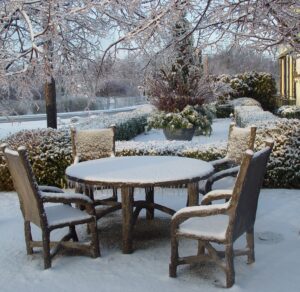Plantings For Winter Interest
Plantings For Winter Interest
When choosing plants for your yard, try to keep the four seasons of interest in mind. Late Fall, Winter and early Spring seasonal interests are often overlooked because a lot of our time is spent inside. With a little forethought you might find yourself paying more attention to your landscape while you are indoors.
- Aside from the obvious evergreen choices like pines, spruces, boxwoods, cypress, etc., search for plants that offer interesting forms, textures, and colors, attract birds and even provide a sculptural element to your landscape.
- Shade trees offer much more than just protection from the sun during hot summer days. Some Oak and Beech varieties, in addition to holding their leaves for a good portion of Winter, can provide unique structural forms with their varying habits. Planetrees, Shagbark Hickory, and again Oaks and Beech trees offer interesting textures and colors while also displaying winter interest with their bark.
- If evergreens are a favorite of yours, check out the weeping and contorted varieties among the wide range of colors available to add a punch to your Winter Garden. Weeping Cypress, Pines and Spruce varieties come in many shapes and forms for both trees & shrubs and should be seen before specifying. Gold Mops Cypress, Fire Chief Arborvitae, and the blues of Bird’s Nest Spruce, among others, will liven up a Winter Landscape. A little bit of extra searching can be well worth your effort if these specimen plants are on your list.
- Ornamental trees including the Red Jewel flowering crab can hold their brightly colored fruits throughout the winter and provide Springtime food for robins and migratory birds. The yellow flowering Vernal Witch-hazel blooms in late Winter offer a glimpse of things to come.
- Deciduous shrubs like red twig dogwood can brighten up a snow-covered yard and the fruits/berries of shrubs like Winterberry can do the same over an extended period. The colorful red fruit of the Winterberry stays on past the first frost and often snow, so that it can become soft enough for the birds to enjoy.
- Perennial flowers and foliage are often pruned back to the ground in late fall; however, leaving coneflowers, Black-eyed Susan’s, and other similar seed-bearing plants, can help sustain a local bird population during difficult foraging times or harsh winters.
- Ornamental grasses can provide strong vertical elements in the winter landscape in addition to different textures via their seed heads and differing leaf types. When combined with remaining perennials, the combination can capture blowing snow and create interesting and beautiful winter sculptures.
Remember, when thinking through your furniture landscapes, to keep the Winter season in mind. You will be surprised by all of the beauty that happens outdoors while you are staying warm inside!

